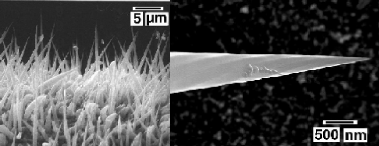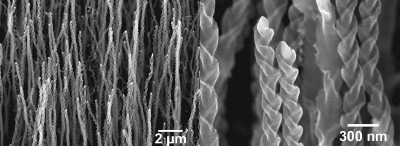Carbon-based nano-structures
Carbon-based nano-structures
Tubular-graphite-cones and carbon-nano-helices

Tubular-graphite-cones

Carbon-nano-helices
In 2002 we
were the first to fabricate tubular-graphite-cones (TGCs) with inner nano-tubes
and carbon-nano-helices (CNHs) via MWCVD. Iron, nickel, and cobalt were
used as growths-catalysts. The micro-structure as well as the properties
of these TGCs and CNHs appear to be unique. TGCs, to our understanding,
consist of identical cylindrical graphite layers stacked in a zigzag-manner.
They are hollow with an inner diameter in the nanometer regime similar
to that of carbon-nano-tubes (CNTs). The tip of a TGC has a diameter of
about 10nm, whereas the base-diameter is on the order of several hundred
nanometers or even some micrometers. Based on the different geometry and
micro-structure, TGCs show an increased performance compared to CNTs rendering
new applications possible. For example, TGCs have a stiffness along their
axis that is comparable to that of CNTs (stiffer than diamond), but are
more stable and stiffer perpendicular to their axis making an application
as canula in medical science possible.
CNHs on the other hand, that look like an italian-noodles (fussili) in
the SEM, consist of carbon-ribbons twisted in a spiral-manner. These ribbons
have a width of about 70-80nm and show lengths of some 10 micrometers.
Their huge area to volume ratio makes them a potential candidate as storage-device
in biotechnological applications.
Our research goal here is to synthesize new carbon-based nano-structures,
to characterize their micro-structure, their electrical, and mechanical
properties as well as to implement these structure in technical applications.
Contact: Thorsten Staedler
